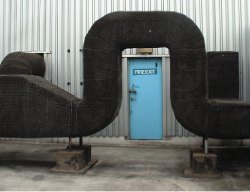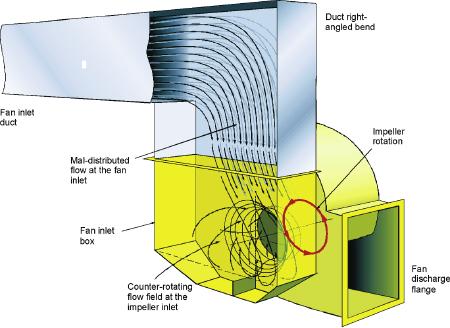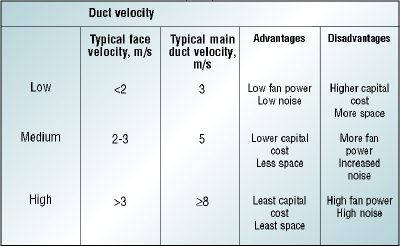Fans of efficiency

This ‘decorative’ arch adds 100 Pa to the resistance of this ductwork.
Over the past eight years, Darren Bryant has encountered many examples of inefficient fan systems. The good news is that achieving energy-efficient fan systems is not at all difficult.My company spends a great deal of time surveying fan systems up and down the country. Whatever the size of building they serve, the same three principles of efficient system design apply when seeking a reduction in running costs.
Avoid excess air supply. To state the obvious, a fan switched off when the building is empty or not in use consumes no energy. But even when the building is in use, set your system to suit the occupancy by half loading or part loading the system. At the same time, question air-change rates, and design the valves accordingly.
Minimise System resistance. System resistance is a necessary evil in moving air from the fan to the served area. You can minimise such running costs by keeping the air speed and the surface area the air comes into contact with to a minimum.
Install the highest efficiency fan. Selecting the correct fan type, size and drive arrangement will ensure a high operating efficiency. But once all these measures are in place, how can we gauge the efficiency of our systems? We need to devise a benchmark against which we can make a comparison, and the one increasingly used is specific fan power. This is the ratio of total motor input power for a given amount of air volume, and is usually expressed as W/l/s or kW/m3/s.
Regulations What are the regulations that govern this practice, and do they have teeth? In April 2003, Part L of the Building Regulations came into force. It defined for the first time a value for specific fan power and stated that new systems must have no greater than 2 W/l/s of air. Owing to constraints from the building fabric, alterations or refurbishment are required to have a specific fan power no greater than 3 W/l/s of air. 2 W/l/s represents 50% efficiency, and 3 W/l/s is 33% efficiency. These values seem low compared with efficiencies of 85 to 90% expected for electric motors. However, many of the systems we audit fall below these requirements. A 30-year trend has shamefully seen systems become less efficient because of the driving down of installation capital costs. A comparison between a 50-year-old theatre in London and a 22-year-old building supermarket reveals some interesting and worrying statistics. The theatre has a large, slow-running centrifugal fan with large cross-sectional-area ductwork. The air flow is 21.5 m3/s, with a supply fan motor of 19 kW and extract-fan motor of 11 kW — giving a total fan power of 30 kW. The specific fan power is 1.4 W/l/s, which is lower than the minimum requirement of Part L2. The annual running cost is £10 512. The supermarket has an airflow 19.5 m3/s, with a supply-fan motor of 43 kW and an extract-fan motor of 21 kW, giving a total fan power of 66 kW. The specific fan power is 3.4 W/l/s — much higher than the 2 W/l/s required in Part L. The annual running cost is £23 126.

Good air inlet and discharge design in ductwork can avoid air swirl, ensuring a good smooth air path in and out of the fan and minimising system resistance.
These figures speak for themselves, and we are left to count the cost of progress. Clearly, this is an indicator of the constraints of initial capital cost on new projects, yet how many organisations are aware of the problem of increased running costs? It would be interesting to check whether the majority of systems installed since April 2003 meet these minimum requirements; sadly there is no post installation check. We are frequently faced with the age-old issue of capital costs versus running costs, and when and whether it is prudent to invest for the longer term. The table provides a useful planning framework and shows how the speed of air travelling down the duct has the greatest influence issue of energy use. You should be looking for a design that optimises life-cycle costs and requires a compromise between initial capital costs and on-going running costs.
Minimising system resistance Once you have compromised on air velocity, minimising system resistance must be considered by avoiding air swirl, since turbulence causes a loss of energy. Good design of air inlet and discharge in ductwork can avoid air swirl, ensuring a good smooth air path in and out of the fan. The diagram illustrate the point. Bends and changes in the direction of ducting increases system resistance and should be avoided as much as possible. Changes in duct size and shape should be avoided as turbulence is created at the edges. Careful selection of components is important, together with ongoing cleanliness of high-efficiency filters and heating and cooling coils. Other building services and requirements must not be forgotten. In one system recently, a very decorative arch was found to add 100 Pa to the system.
Efficient fan-type selection The importance of selecting the right type of fan type and size for the volume and pressure required must be emphasised. We have found axial flow fans which can be very efficient at low pressures installed against 1000 Pa; a high-efficiency backward-curved centrifugal fans would have been a more efficient selection.

The influence of air flow velocity through the fan system
Fan size and duty point In an existing system it is easy to know the system resistance, because it can be measured. For new systems, designers have to calculate system resistance and then add a safety margin. In practice, system resistances are lower than design.
Motor and drive selection Significant amounts of energy can be lost through the drive arrangement for a fan. There are advantages of EFF1 motors over EFF2 and 3. But a belt-drive can have frictional losses of 2 to 15%, depending on belt type, alignment and power transmitted. Using variable-speed drives (both AC and DC) gives us the option of direct drive to remove the frictional losses and maintenance of belt drives. For new designs, belt drives should certainly be avoided as pulley changes at commissioning are no longer required when variable-speed drives are installed.
Methods of varying volume With the development of AC and DC variable-speed drives over the past 10 years, old mechanical methods such as backward-curved fans with discharge-damper control, inlet guide vanes, forward-curved fans with outlet dampers and eddy-coupling variable-speed drives are being phased out, due to speed control offering efficiencies close to ideal for a variable-volume system. We can summarise good fan system design and maintenance practice by how they can achieve the lowest specific fan power or carbon protection index rating as stated in Part L2.
Avoid excess air flow and velocity Challenge the air-change rates, look at recent building research and good practice guides to compare suggested air-change rates. Introduce demand ventilation by installing sensors and speed-control equipment so that your system matches occupancy levels.
Minimise system resistance Use smooth, short, straight duct work and select components such as high-efficiency filters with low pressure drops.
Efficient fan, motor and drive selection Select a fan design and size to match the volume/pressure characteristic. Specify a correctly sized EFF1 — not less than 50% loaded. Avoid belt-drive losses if speed control is available and select speed control with lowest internal losses for efficient variable-speed drive. Finally, energy efficient system design is the key to achieving meaningful savings. Fans use 18% of the UK’s non-domestic energy according to the 2002 SAVE programme market study and produce 14 Mt of carbon dioxide a year. I believe that better system design can cut running costs by 70%. This would have a huge impact on the amount of carbon dioxide produced by running fans. By following the relatively straightforward principles above, starting with a proper audit, there is no reason why new and refurbished systems could not reap the benefits.
Darren Bryant is managing director of Efficient Air
Related articles:











